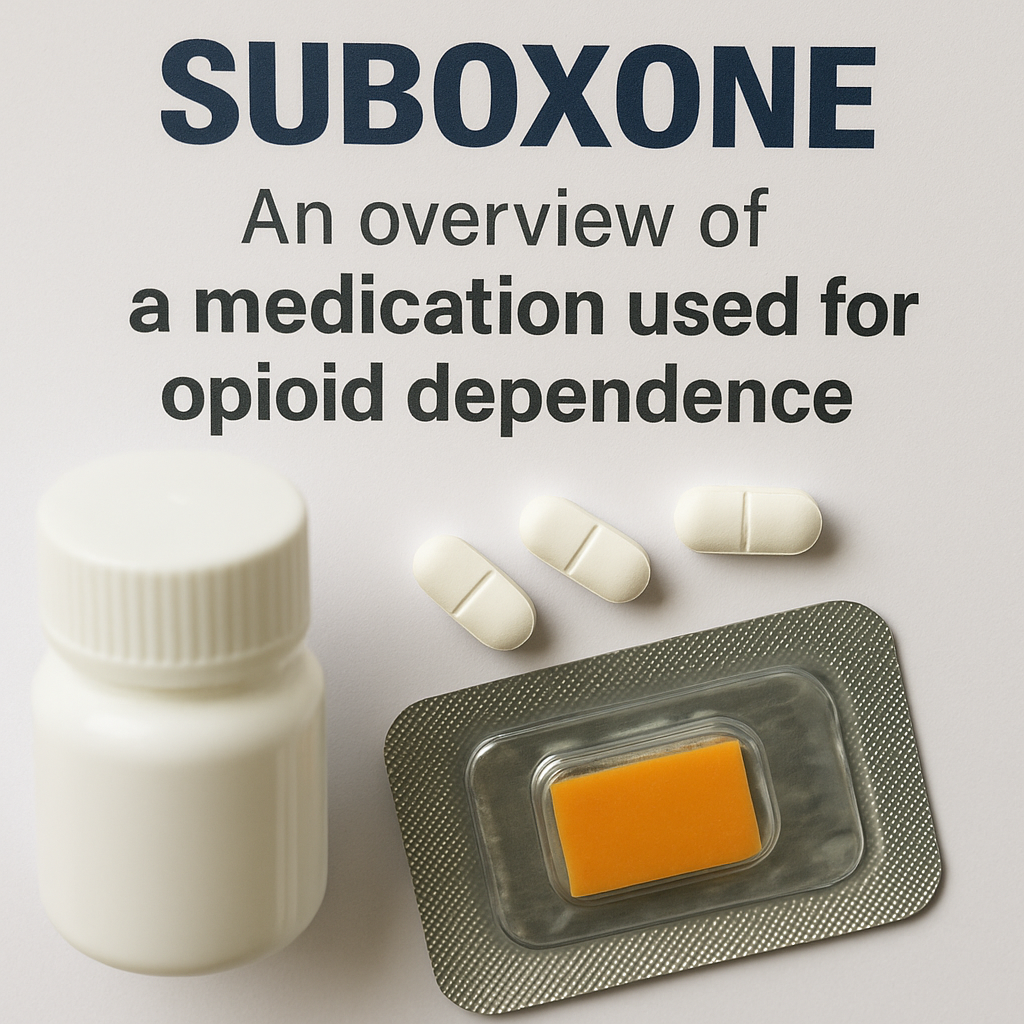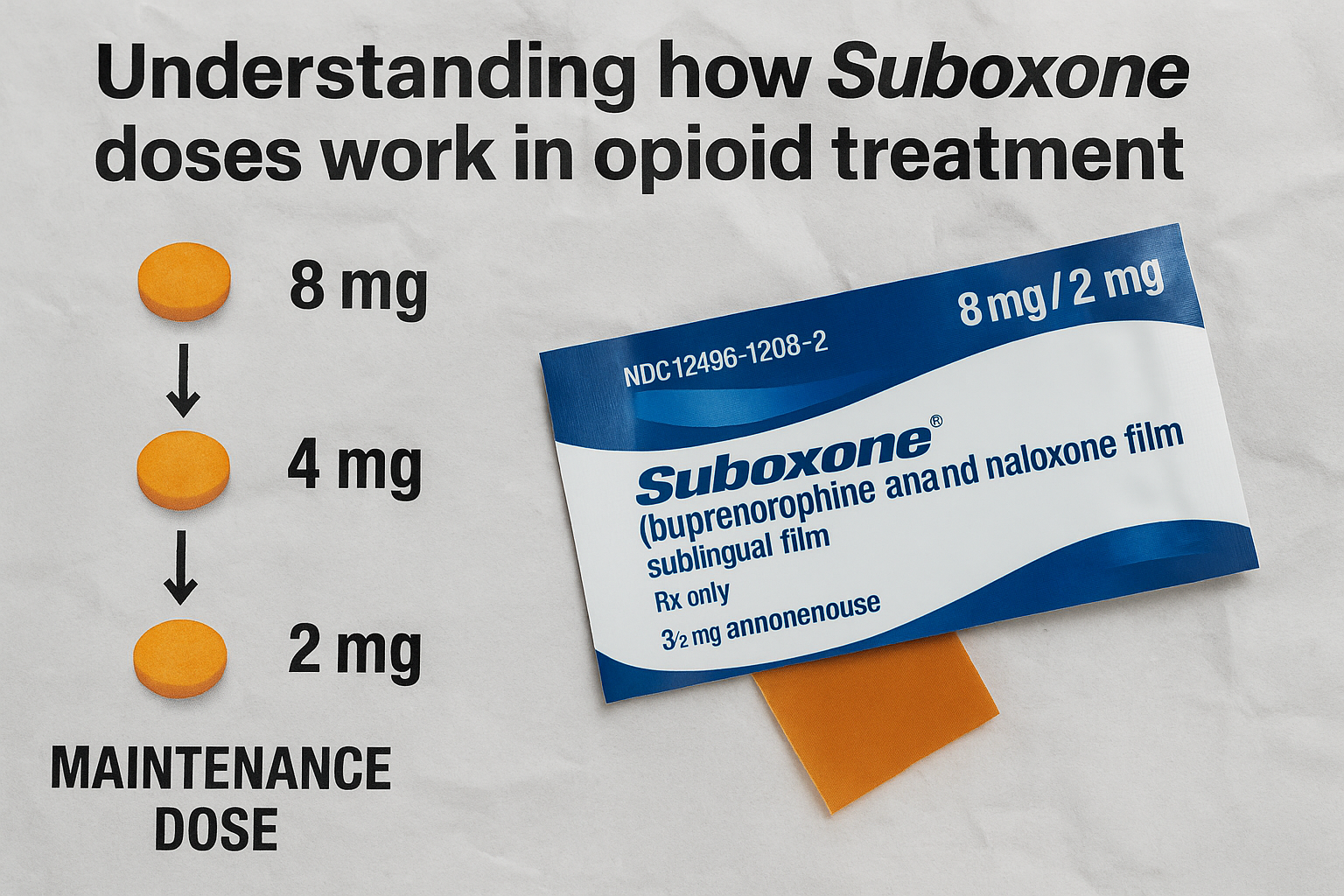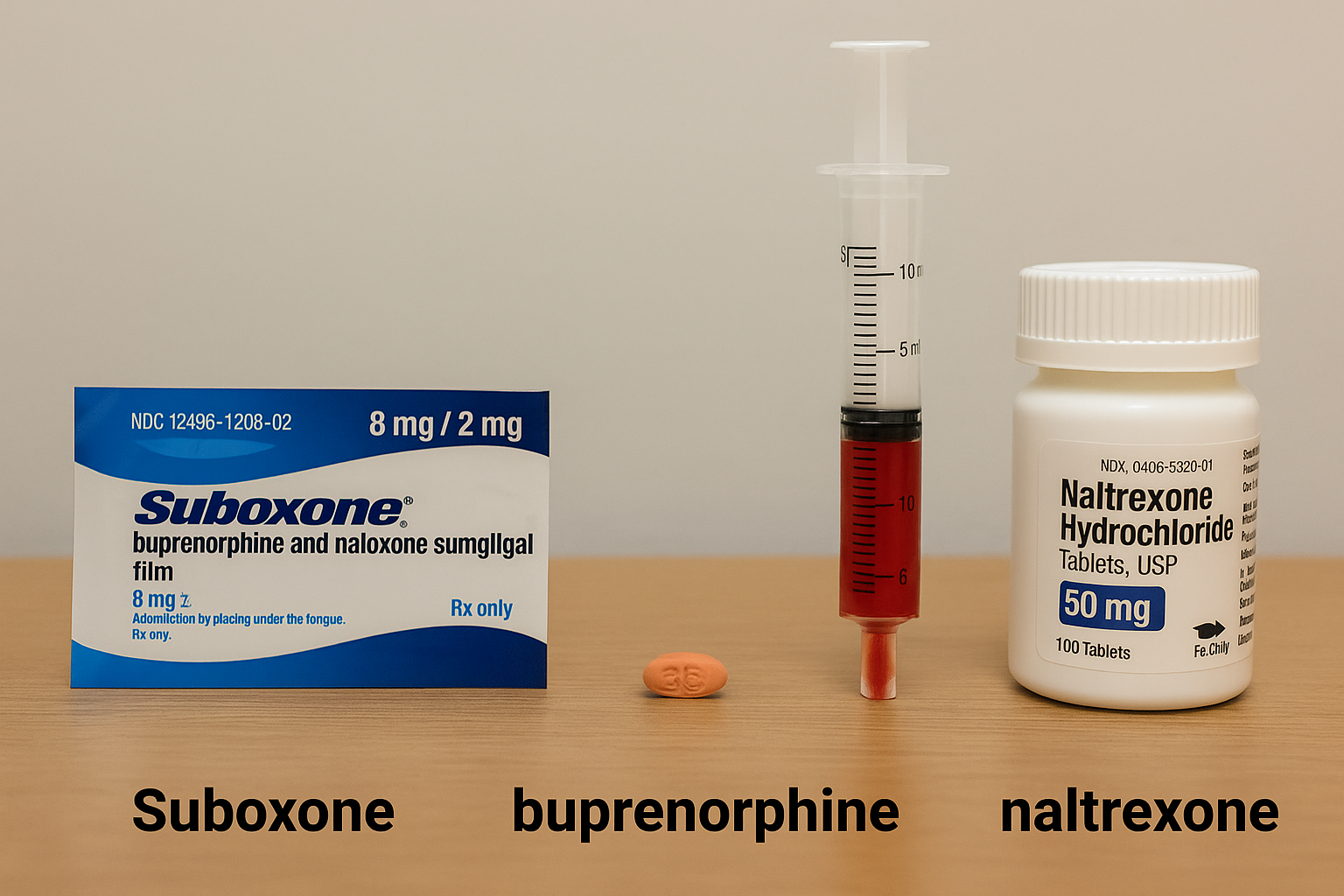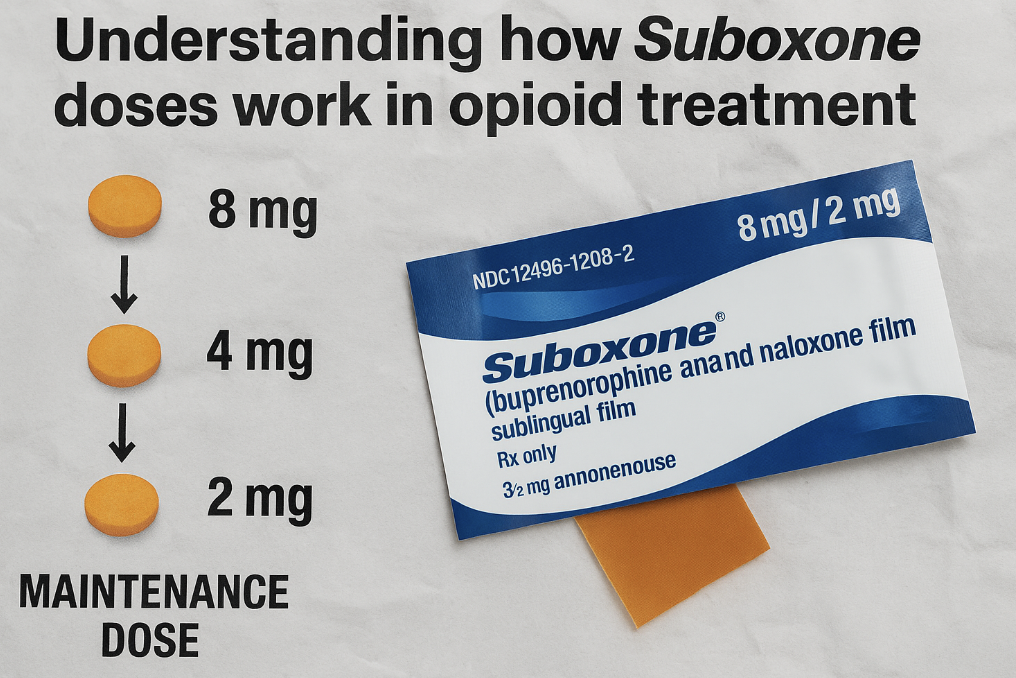Curious about the right doses of Suboxone for opioid dependence? This guide explains the initial and maintenance doses and how they are adjusted. Learn how healthcare providers tailor Suboxone dosing to individual needs.
Key Takeaways
- Suboxone combines buprenorphine and naloxone to alleviate withdrawal symptoms and deter misuse in opioid dependency treatment.
- Dosing of Suboxone varies based on individual needs, with an initial dose of 2-4 mg of buprenorphine usually required, increasing to a maintenance range of 16-24 mg as treatment progresses.
- Close monitoring by healthcare providers is essential for adjusting Suboxone doses to manage efficacy and minimize side effects, particularly for special populations such as pregnant women and the elderly.
What Is Suboxone? An Overview of the Medication
Suboxone is a medication used primarily in Medication-Assisted Treatment (MAT) for opioid addiction. It combines two active ingredients: buprenorphine and naloxone. Buprenorphine is a partial opioid agonist, meaning it activates opioid receptors in the brain but to a much lesser degree than full agonists like heroin or methadone. This drug combination helps to alleviate withdrawal symptoms and cravings without producing the intense euphoria associated with opioid abuse. The dosage can include mg of buprenorphine to ensure effective treatment.
Naloxone, on the other hand, is an opioid antagonist. This means it:
- Blocks opioid receptors, counteracting the effects of opioids.
- Has minimal effects when taken as prescribed.
- Induces withdrawal symptoms if buprenorphine naloxone is misused (for example, by injecting), deterring abuse.
The main therapeutic goals of Suboxone in opioid dependence treatment are to suppress withdrawal symptoms and reduce cravings, thereby supporting long-term recovery. Suboxone is available in various forms, including sublingual films and tablets, which dissolve under the tongue. This method of administration ensures that the medication is absorbed directly into the bloodstream, providing effective relief from withdrawal symptoms.
Grasping the balance between buprenorphine and naloxone in Suboxone helps in understanding its role in treating opioid addiction. These two components together make Suboxone an effective tool in the journey towards recovery.

How Do Suboxone Doses Work?
Suboxone comes in different forms, including sublingual film and suboxone film tablets. Each form has its own specific suboxone dosage guidelines, but the core principles remain the same. The medication is designed to be taken sublingually, meaning it should dissolve under the tongue to ensure proper absorption until the film is completely dissolved.
Dosing Suboxone varies based on individual needs, starting with an initial dose and progressing to a maintenance dose. The initial dose, often referred to as the starting dose, is typically lower and is intended to alleviate withdrawal symptoms without overwhelming the body’s opioid receptors. As treatment progresses, the dose may be adjusted to maintain its effectiveness in suppressing withdrawal symptoms and reducing cravings.
Suboxone’s effectiveness in treating opioid dependence comes from its ability to suppress withdrawal symptoms and reduce cravings, helping patients stabilize and focus on their recovery. The prescribed dose of Suboxone is tailored to meet individual needs to achieve these goals.
Administering Suboxone via the sublingual route ensures direct absorption into the bloodstream, providing rapid relief from withdrawal symptoms and cravings. This method also minimizes the potential for abuse, particularly with sublingual or buccal use.

What Are the Recommended Doses of Suboxone for Treatment?
The initial buprenorphine dose for treating opioid dependence with Suboxone typically ranges from 2-4 mg of buprenorphine on the first dose, crucial for managing early withdrawal symptoms and starting stabilization. The aim is to find the lowest effective dosage of suboxone that alleviates withdrawal symptoms without causing excessive sedation or other side effects.
As treatment progresses, the dose may be increased to reach an adequate treatment dose. For most patients, this maintenance dosage:
- Ranges from 16-24 mg per day
- Provides consistent relief from withdrawal symptoms and cravings
- Helps patients focus on their recovery and other aspects of their lives.
Dose adjustments depend on the individual’s response to the medication. If withdrawal symptoms persist or cravings return, the dose may be increased; if side effects are problematic, the dose may be reduced. Close monitoring by a healthcare provider ensures that the Suboxone dose is optimized for each patient’s needs.
The induction dosage is another critical aspect of Suboxone treatment. This phase involves:
- Gradually increasing the dose until a stable, effective dose is reached.
- Aiming to stabilize the patient as quickly and safely as possible.
- Minimizing withdrawal symptoms and cravings during the induction treatment.
In emergencies like an overdose or severe withdrawal symptoms, the Suboxone dose may need rapid adjustment. Healthcare providers will make these decisions based on the patient’s condition and response to the medication.

How to Adjust the Dose of Suboxone Based on Your Needs
Adjusting the Suboxone dose during the initial induction phase is crucial for effective treatment. This phase involves close monitoring by a healthcare provider to determine the appropriate dose that will manage withdrawal symptoms without causing significant side effects.
There are various scenarios for adjusting doses, including reducing or increasing the dose based on the patient’s progress. For example, if a patient experiences persistent withdrawal symptoms, the dose may be increased. Conversely, if a patient experiences excessive sedation or other side effects, the dose may be reduced.
Collaborating with a healthcare provider is vital for fine-tuning the Suboxone dose. The provider will consider factors such as the patient’s response to the medication, the severity of withdrawal symptoms, and any side effects that occur. This collaborative approach ensures that the dose of Suboxone is tailored to meet the individual’s needs.
Examples of dosage adjustments include increasing the dose to manage withdrawal symptoms or reducing it to minimize side effects. These adjustments are made carefully and gradually to avoid causing additional withdrawal symptoms or other complications.
Common Suboxone Dose Ranges and What They Mean
Common Suboxone doses for opioid dependence range from 2 mg to 4 mg per day to 16-24 mg per day, each serving a specific purpose in treatment, including 2 mg 0.5. For example, lower doses are often used during the initial induction phase to manage early withdrawal symptoms, while higher doses are used for maintenance treatment.
The potential outcomes of different doses vary in terms of effectiveness and side effects:
- Lower doses may be sufficient for managing mild withdrawal symptoms.
- Higher doses are often necessary for more severe cases, especially in situations involving precipitated and prolonged withdrawal.
- Moderate withdrawal may require careful consideration of dosing strategies, including multiple doses.
- Higher doses carry a greater risk of side effects, such as sedation and respiratory depression, which should be considered when calculating the total dose, including divided doses.
In special cases, such as patients with a high level of opioid tolerance, the highest dose of 24 mg per day may be prescribed. These higher doses of long acting opioids are used to provide adequate relief from withdrawal symptoms and cravings, ensuring that the patient can stabilize and focus on their recovery. The appropriate opioid dose is crucial for effective management.
Maintaining a stable dosage is crucial for Suboxone’s effectiveness. Regular monitoring and adjustments by a healthcare provider ensure the dose remains effective and minimizes side effects. This approach helps patients achieve long-term recovery and avoid relapse.
What Happens If You Take Too Much Suboxone?
Taking too much Suboxone can lead to serious health risks, including Suboxone overdose, with signs like respiratory depression, sedation, and loss of consciousness. These symptoms can be life-threatening and require immediate medical attention.
The potential for respiratory depression is particularly concerning, as it can lead to decreased oxygen levels in the body and, in severe cases, death. Other serious effects of Suboxone overdose include severe sedation and coma. These risks highlight the importance of adhering to the prescribed dose and avoiding taking too much Suboxone.
If a Suboxone overdose is suspected, follow these steps:
- Call emergency services immediately.
- While waiting for medical help to arrive, try to keep the person awake and breathing.
- Emergency medical personnel may administer naloxone to reverse the effects of the opioid overdose and provide additional supportive care.
Immediate medical attention in overdose situations is crucial. Rapid response can significantly improve the chances of recovery and prevent long-term health complications. This underscores the need for patients to follow their prescribed Suboxone dosage and seek emergency treatment to avoid misuse.
Risks and Side Effects of Suboxone Dosing
Common side effects of Suboxone include headache, constipation, nausea, and sweating. These side effects are generally mild and can be managed with supportive care and symptom-specific treatments.
More serious but less common side effects include liver damage and opioid withdrawal syndrome. Liver damage may manifest as jaundice, dark urine, and abdominal pain. Opioid withdrawal syndrome can occur if the dose of Suboxone is not sufficient to suppress withdrawal symptoms, leading to acute withdrawal symptoms.
The Suboxone dosage can influence the frequency and severity of side effects. Higher doses are more likely to cause sedation and respiratory depression, while lower doses may not manage withdrawal symptoms effectively. This balance highlights the importance of finding the right dose for each individual patient.
Monitoring for withdrawal signs and symptoms is crucial during Suboxone treatment. Patients should report any new or worsening symptoms to their healthcare provider, who can adjust the dose as needed to manage side effects and withdrawal symptoms.
How Long Should You Stay on Suboxone?
The duration of Suboxone treatment varies based on individual needs and treatment goals. Some patients may require long-term maintenance treatment, while others may be able to taper off Suboxone gradually.
Tapering off Suboxone involves gradually reducing the dose over time to minimize withdrawal symptoms, ideally under the supervision of a healthcare provider to ensure safety and effectiveness.
Factors influencing the duration of Suboxone treatment include the history of opioid use, the severity of addiction, and the patient’s treatment goals. Patients with a long history of opioid use or severe addiction may need longer treatment periods to achieve stable recovery.
Gradual dose reduction is crucial to avoid withdrawal symptoms and ensure a smooth transition off Suboxone. Patients should work closely with their healthcare provider to develop a tapering plan that meets their needs and supports their recovery goals.
Suboxone Dosing vs. Other Opioid Dependence Treatments
Suboxone vs Methadone is a common comparison in opioid dependence treatment, with each medication offering unique benefits and risks. Each treatment has unique benefits and drawbacks, and the choice depends on the patient’s individual needs.
Methadone fully activates opioid receptors in the brain, beneficial for patients with high levels of opioid dependence, but also carrying a higher risk of overdose and addiction compared to Suboxone. Methadone requires daily visits to a clinic for administration, which can be a barrier for some patients.
Naltrexone blocks the effects of opioids and is often used in patients who have detoxified from opioids and are seeking to maintain abstinence in the context of opioid use disorder. Naltrexone does not alleviate withdrawal symptoms or suppresses opioid withdrawal signs, making it less suitable for early-stage recovery.
Suboxone is often the preferred choice due to its combination of buprenorphine and naloxone. The partial opioid agonist effect of buprenorphine helps to suppress withdrawal symptoms and reduce cravings, while naloxone deters misuse. This combination makes Suboxone a versatile and effective option for many patients with opioid dependence.

Suboxone Dosing in Special Populations
Special considerations are needed when dosing Suboxone for populations like pregnant or breastfeeding women, the elderly, and individuals with liver dysfunction or other comorbid conditions.
For pregnant or breastfeeding women, Suboxone dosing must balance treatment benefits with potential risks to the baby. Buprenorphine monotherapy (without naloxone) is often preferred in these cases to minimize exposure to naloxone. Close monitoring by a healthcare provider ensures the safety of both mother and child.
Elderly patients may require lower doses of Suboxone due to metabolic changes and increased medication sensitivity. The risk of side effects like sedation and respiratory depression is higher in this population, necessitating careful dose adjustments and monitoring.
Individuals with liver dysfunction may require lower doses or alternative dosing schedules due to impaired medication metabolism and systemic exposure. Regular liver function tests are recommended to monitor for potential liver damage and adjust the dose accordingly.
How to Safely Take Suboxone and Stick to Your Dose
Taking Suboxone as prescribed ensures its effectiveness and minimizes the risk of side effects. When a doctor prescribes it, patients should follow their healthcare provider’s instructions and avoid changing their dose without consultation.
If a dose is missed, patients should:
- Take the missed dose as soon as they remember, unless it is almost time for the next dose.
- If it is almost time for the next dose, skip the missed dose and continue with their regular dosing schedule.
- Avoid doubling up on doses for a missed dose, as it is not recommended.
Patients should avoid combining Suboxone with substances like alcohol and benzodiazepines that increase the risk of side effects. These combinations can lead to severe sedation, respiratory depression, and even overdose.
Adhering to the prescribed dosing schedule is crucial for the success of Suboxone treatment and the overall treatment plan. Tools like medication reminders, support groups, and regular follow-up appointments can help patients stay on track.
Bottom Line: Doses of Suboxone
Accurate dosing and medical guidance are paramount in the effective use of Suboxone for opioid dependence treatment. Patients should work closely with their healthcare providers to determine the appropriate dose, make necessary adjustments, and monitor for side effects.
Consulting with a healthcare provider ensures personalized dosing recommendations and addresses concerns or questions about Suboxone treatment. This collaborative approach ensures that patients receive the best possible care and support throughout their recovery journey. A doctor recommends suboxone for those seeking effective treatment options.
Understanding Suboxone dosing is a critical component of achieving successful treatment outcomes. By following medical advice and adhering to the prescribed dosing regimen, patients can manage their opioid dependence and work towards long-term recovery.
FAQs About Suboxone Dosing
Can I take Suboxone if I am pregnant?
Yes, Suboxone can be taken during pregnancy, but it is advisable to use buprenorphine monotherapy and to have close monitoring by a healthcare provider to safeguard both the mother and baby.
What should I do if I miss a dose?
If you miss a dose of Suboxone, take it as soon as you remember, unless it is nearly time for your next dose; in that case, skip the missed dose and resume your regular schedule. Avoid doubling up on doses.
What if Suboxone isn’t working for me?
If Suboxone is not effective for you, it is crucial to consult your healthcare provider for possible dosage adjustments or alternative treatment options to address your needs.
Can I drink alcohol while taking Suboxone?
It is advisable to avoid drinking alcohol while taking Suboxone, as it can significantly raise the risk of severe sedation and overdose. Prioritizing your safety is essential, so refrain from combining these substances.
How long will I need to stay on Suboxone?
The duration of Suboxone treatment is highly individualized, often ranging from short-term tapering to long-term maintenance based on your specific needs and goals. It is essential to consult with a healthcare provider for a tailored approach.
















